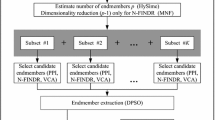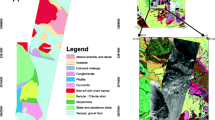Abstract
The Hyperion data are broadly available for different parts of the world. Considering the spatial resolution of Hyperion (30 × 30 m2), it is rarely possible to find a pixel consisting of only one mineral. Spectral unmixing is therefore an important procedure in which dataset pixels are demixed into various constituents. Endmember determination is the key stage in spectral unmixing. The algorithms which are not depended on the existence of pure pixels in images are more efficient particularly when the spatial resolution is low (e.g., Hyperion data). On the other hand, the lower signal-to-noise ratio of Hyperion data is a disadvantage. Minimum volume-constrained nonnegative matrix factorization (MVC-NMF) is an appropriate non-pure pixel-based algorithm in low SNR conditions. Still, MVC-NMF is based on a gradient technique and is therefore problematic in the case of large amount of data. Particle swarm optimization (PSO) is a metaheuristic algorithm and computational simplicity is its main advantage. The minimum volume-constrained version of PSO (MVC-PSO) was then investigated on Western Ardabil Hyperion data and the results were compared with MVC-NMF. To validate the accuracy of the results, 20 surface samples were collected and analyzed by spectrometry and X-ray diffraction (XRD). Measured spectra by analytical spectral devices Inc. FieldSpec were used to create a native spectral library. Native spectra as well as United States Geological Survey mineral spectral library were applied for identification of unknown endmembers spectra. The XRD results were implemented for quantitative validation of abundances maps of endmembers using Average Abundance Ratio.





Similar content being viewed by others
References
Aguilar, P. L., Plaza, A., Cobo, P. M., & Pérez, R. M. (2000). Endmember extraction from hyperspectral images using self-organizing neural network. WIT Transactions on Information and Communication Technologies, 24, 255–264.
Baniadam, F. (2008). Report of promising regions of 1:100000 Geological Map of Lahrud. Tehran: Geologocal Survey of Iran.
Beheshti, Z., & Shamsuddin, S. M. (2013). A review of population-based meta-heuristic algorithm. International Journal of Advances in Soft Computing and its Applications, 5(1), 1–35.
Borengasser, M., Hungate, W. S., & Watkins, R. (2008). Hyperspectral remote sensing, principles and applications. Taylor & Francis Group: CRC Press.
Chang, C. I. (2007). Hyperspectral data exploitation: Theory and applications. New Jersey: Wiley-Interscience.
Chang, C. I., & Du, Q. (2004). Estimation of number of spectrally distinct signal sources in hyperspectral imagery. IEEE Transactions on Geoscience and Remote Sensing, 42(3), 608–619.
Chen, W., Yu, X., & Wang, H. (2010). PSO-GA on endmember extraction for hyperspectral imagery. In International confrence on computer application and system modeling (ICCASM), Taiyuan, China, Oct 22–24.
Cui, J., Li, X., & Zhao, L. (2011). Linear mixture analysis for hyperspectral imagery in the presence of less prevalent materials. IEEE Transactions on Geoscience and Remote Sensing, 51(7), 4019–4031.
Dobigeon, N., Tourneret, J.-Y., Richard, C., Bermudez, J. C. M., McLaughlin, S., & Hero, A. O. (2014). Nonlinear unmixing of hyperspectral images: Models and algorithms. IEEE Signal Processing Magazine, 31(1), 82–94.
Harsanyi, J., Farrand, W., & Chang, C. I. (1993). Determining the number and identity of spectral endmembers: an integrated approach using Neyman-Pearson eigen-thresholding and iterative constrained RMS error minimization. In Proceedings of the 9th thematic conference on geologic remote sensing, Pasadena, California, USA, February 8–11.
Kennedy, J., & Eberhart, R. (1995). Particle swarm optimization. Proceedings of the IEEE International Conference on Neural Networks, 4, 1942–1948.
Keshava, N. (2003). A survey of spectral unmixing algorithms. Lincoln Laboratory Journal, 14(1), 55–78.
Kruse, F. A., Boardman, J. W., & Huntington, J. F. (2003). Comparison of AVIRIS and hyperion for hyperspectral mineral mapping. IEEE Transactions on Geoscience and Remote Sensing, 41(6), 1388–1400.
Liu, J., & Zhang, J. (2012). A new maximum simplex volume method based on house holder transformation for endmember extraction. IEEE Transactions on Geoscience and Remote Sensing, 50(1), 104–118.
Maneiro, M., & Xiaojian, X. (2010). Particle swarm optimization algorithm for unmixing hyperspectral image. In IEEE 10th international conference on signal processing (ICSP), Beijing, China, Oct 24–28.
Miao, L., & Qi, H. (2007). Endmember extraction from highly mixed data using minimum volume constrained nonnegative matrix factorization. IEEE Transactions on Geoscience and Remote Sensing, 45(3), 765–777.
Mineral exploration report of Dost-Bayli area, By Zarnab exploration company, 2003.
Mozaffar, M. H., Zoej, M. J. V., Sahebi, M. R., & Rezaei, Y. (2008). Vegetation endmember extraction in hyperion images. The International Archives of the Photogrammetry, Remote Sensing and Spatial Information Sciences, XXXVII(B7), 409–412.
Nouri, T., & Oskouei, M. M. (2016). Processing of Hyperion data set for detection of indicative minerals using a hybrid method in Dost-Bayli. Iran. International Journal of Remote Sensing, 37(20), 4923–4947.
Nouri, T., Oskouei, M. M., & Zekri, H. (2016). A comparison study of ORASIS and VCA for mineralogical unmixing of hyperspectral data. Journal of the Indian Society of Remote Sensing, 44(5), 723–733.
Omran, M. G. H., Engelbrecht, A. P., & Salman, A. (2005). A PSO-based endmember selection method for spectral unmixing of multispectral satellite images. International Journal of Computational Intelligence, 2(2), 124–132.
Plaza, A. J., & Chang, C. I. (2007). High performance computing in remote sensing. Taylor and Francis Group: Chapman & Hall CRC.
Plaza, J., & Hendrix, E. M. T. (2011). On endmember identification in hyperspectral images without pure pixels: a comparison of algorithms. Journal of Mathematical Imaging and Vision, 42(2–3), 163–175.
Plaza, A., Martinez, P., Perez, R., & Plaza, J. (2004). A quantitative and comparative analysis of endmember extraction algorithms from hyperspectral data. IEEE Transactions on Geoscience and Remote Sensing, 42(3), 650–663.
Poli, R., Kennedy, J., & Blackwell, T. (2007). Particle swarm optimization, an overview. Swarm Intell, 1, 33–57.
Li, H. Ch., Song, M., & Chang, Ch. I. (2015). Simplex volume analysis for finding endmembers in hyperspectral imagery. In Satellite data compression, communication and processing XI (ST127), SPIE international symposium on SPIE sensing technology + applications, Baltimore, MD, April 20–24.
Sun, X., Zhang, B., Gao, L., & Yang, L. (2012). An innovative method of endmember extraction of hyperspectral remote sensing image using Elitist Ant System (EAS). In International conference on industrial control and electronics engineering (ICICEE), Xi’an, China, Aug 23–25.
Winter, M. E. (2004). A proof of the N-FINDR algorithm for the automated detection of endmembers in a hyperspectral image. In SPIE conference on algorithms and technologies for multispectral, hyperspectral, and ultraspectral imagery, Orlando, FL, August 12, 31–41.
Yagiura, M., & Ibaraki, T. (2001). On metaheuristic algorithms for combinatorial optimization problems. Systems and Computers in Japan, 32(3), 33–55.
Zhang, B., Sun, X., Gao, L., & Yang, L. (2011a). Endmember extraction of hyperspectral remote sensing Images based on the Ant Colony Optimization (ACO) algorithm. IEEE Transactions on Geoscience and Remote Sensing, 49(7), 2635–2646.
Zhang, B., Sun, X., Gao, L., & Yang, L. (2011b). Endmember extraction of hyperspectral remote sensing images based on the discrete particle swarm optimization algorithm. IEEE Transactions on Geoscience and Remote Sensing, 49(11), 4173–4176.
Zhang, B., Zhuang, L., Gao, L., Luo, W., Ran, Q., & Du, Q. (2014). PSO-EM: A hyperspectral unmixing algorithm based on normal compositional model. IEEE Transactions on Geoscience and Remote Sensing, 52(12), 7782–7792.
Author information
Authors and Affiliations
Corresponding author
About this article
Cite this article
Nouri, T., Oskouei, M.M., Alizadeh, B. et al. Improvement of the MVC-NMF Problem Using Particle Swarm Optimization for Mineralogical Unmixing of Noisy Hyperspectral Data. J Indian Soc Remote Sens 47, 541–550 (2019). https://doi.org/10.1007/s12524-018-0885-9
Received:
Accepted:
Published:
Issue Date:
DOI: https://doi.org/10.1007/s12524-018-0885-9




